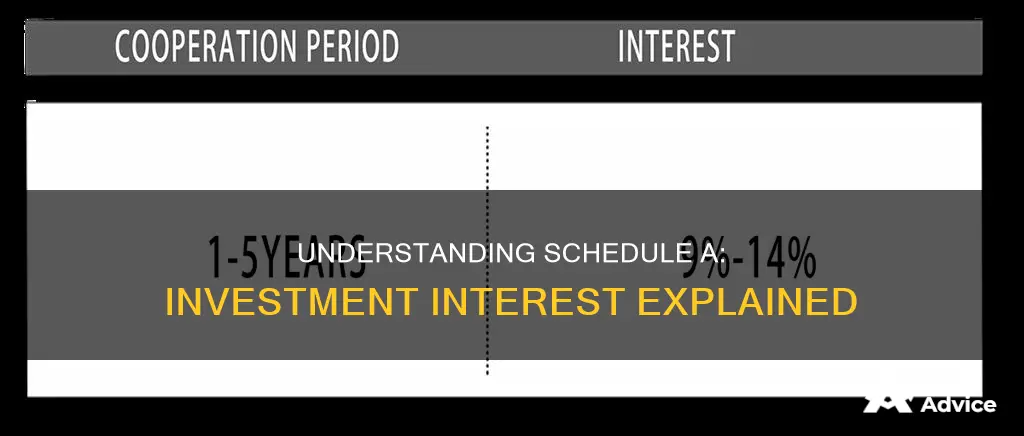
Investment interest is interest paid or accrued on indebtedness incurred to purchase or carry property held for investment. Investment interest expenses are deductible and are limited to the amount of investment income received, such as dividends and interest. Personal investment interest expense is reported on Schedule A of 1040. Investment interest can only be claimed by itemizing deductions on Schedule A and filing Form 4952.
| Characteristics | Values |
|---|---|
| Definition | An investment interest expense deductible is limited to the amount of investment income received, such as dividends and interest |
| Example | A common example of this type of expense is the application of proceeds from a margin loan, taken out with a brokerage, in order to purchase stock |
| Where to report | Personal investment interest expense is reported on Schedule A of 1040 |
| Requirements | To claim the deduction for investment interest expenses, you must itemize your deductions and file Form 4952 |
| Exceptions | Interest incurred from a 'passive activity' investment generally does not qualify for the investment interest deduction |
What You'll Learn
- Investment interest expenses are limited to the amount of investment income received
- Investment interest expenses are reported on Schedule A of 1040
- Investment interest expenses can be claimed by itemising deductions on Schedule A and filing Form 4952
- Investment interest expenses do not include qualified residence interest
- Investment interest expenses do not include interest incurred in a passive activity

Investment interest expenses are limited to the amount of investment income received
A common example of this type of expense is the application of proceeds from a margin loan, taken out with a brokerage, in order to purchase stock. A key aspect of investment interest expense is the property held for investment, which the proceeds from the loan were used to purchase.
Interest incurred from a 'passive activity' investment generally does not qualify for the investment interest deduction. A passive activity is a business or trade in which you hold an ownership interest but in which you don't actually participate. For example, if you borrow money to buy a house to rent out, the interest isn't deductible as investment interest. However, if a passive activity generates portfolio income (interest, dividends, etc.), the portion of the passive activity interest expense allocable to the portfolio income is investment interest rather than passive activity interest.
Understanding the Power of Compound Interest to Triple Investments
You may want to see also

Investment interest expenses are reported on Schedule A of 1040
A passive activity is a business or trade in which you hold an ownership interest but in which you don't actually participate. For example, if you borrow $20,000 to buy a 10% stake in a friend's car wash, that stake is an investment, but unless you are there washing cars (or doing some other work), it's a passive activity because you're not materially involved in running the business.
The deduction for investment interest expenses is limited to the amount of taxable investment income earned in the same year. Investment interest can only be claimed by itemizing deductions on Schedule A and filing Form 4952. Interest incurred from a 'passive activity' investment generally does not qualify for the investment interest deduction.
A common example of this type of expense is the application of proceeds from a margin loan, taken out with a brokerage, in order to purchase stock.
Investing in Low-Interest Rate Environments: Should You?
You may want to see also

Investment interest expenses can be claimed by itemising deductions on Schedule A and filing Form 4952
If an investment is held for both business and personal gain, then any income received must be allocated proportionally between them. Personal investment interest expense is reported on Schedule A of 1040. A common example of this type of expense is the application of proceeds from a margin loan, taken out with a brokerage, in order to purchase stock.
Interest incurred from a 'passive activity' investment generally does not qualify for the investment interest deduction. A passive activity is a business or trade in which you hold an ownership interest but in which you don't actually participate. For example, if you borrow money to buy a 10% stake in a friend's car wash, that stake is an investment, but unless you are there washing cars (or doing some other work), it's a passive activity because you're not materially involved in running the business.
Smart Investments: Higher Interest Options for Your Money
You may want to see also

Investment interest expenses do not include qualified residence interest
Investment interest expenses are deductible up to the amount of investment income received, such as dividends and interest. If an investment is held for both business and personal gain, then any income received must be allocated proportionally between them. Personal investment interest expense is reported on Schedule A of 1040.
Understanding Foreclosure Interest: A Guide to Smart Investing
You may want to see also

Investment interest expenses do not include interest incurred in a passive activity
Investment interest expenses are deductible up to the amount of investment income received, such as dividends and interest. Personal investment interest expenses are reported on Schedule A of 1040. However, investment interest expenses do not include interest incurred in a passive activity. This means that if you borrow money to invest in a business or trade in which you hold an ownership interest but do not actively participate, the interest on that loan is not deductible as an investment interest expense. For example, if you borrow money to buy a house to rent out, the interest on that loan is not deductible as investment interest. This is because rental activity is generally considered a passive activity. Similarly, if you borrow money to buy a stake in a friend's business but do not actually work in the business, the interest on that loan is also not deductible as an investment interest expense.
It is important to note that while interest incurred from a passive activity investment generally does not qualify for the investment interest deduction, there may be exceptions. For instance, if a passive activity generates portfolio income (interest, dividends, etc.), the portion of the passive activity interest expense allocable to the portfolio income may be considered investment interest rather than passive activity interest.
Interest Rate Hike: Boon or Bane for Investors?
You may want to see also
Frequently asked questions
Investment interest is interest paid or accrued on indebtedness incurred to purchase or carry property held for investment. Investment interest is reported on Schedule A of 1040.
A common example of this type of expense is the application of proceeds from a margin loan, taken out with a brokerage, in order to purchase stock.
Investment interest does not include qualified residence interest or interest incurred in a passive activity. A passive activity is a business or trade in which you hold an ownership interest but in which you don't actually participate.







